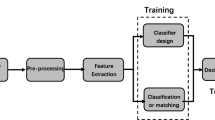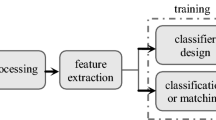Abstract
This paper presents an efficient ear recognition technique which derives benefits from the local features of the ear and attempt to handle the problems due to pose, poor contrast, change in illumination and lack of registration. It uses (1) three image enhancement techniques in parallel to neutralize the effect of poor contrast, noise and illumination, (2) a local feature extraction technique (SURF) on enhanced images to minimize the effect of pose variations and poor image registration. SURF feature extraction is carried out on enhanced images to obtain three sets of local features, one for each enhanced image. Three nearest neighbor classifiers are trained on these three sets of features. Matching scores generated by all three classifiers are fused for final decision. The technique has been evaluated on two public databases, namely IIT Kanpur ear database and University of Notre Dame ear database (Collections E). Experimental results confirm that the use of proposed fusion significantly improves the recognition accuracy.
Similar content being viewed by others
Explore related subjects
Discover the latest articles, news and stories from top researchers in related subjects.References
University of Notre Dame ear database, Collection E. http://www.nd.edu/cvrl/CVRL/DataSets.html.
Bay, H., Ess, A., Tuytelaars, T., & Van Gool, L. (2008). Speeded-up robust features (SURF). Computer Vision and Image Understanding, 110(3), 346–359.
Bay, H., Tuytelaars, T., & Van Gool, L. (2006). SURF: speeded up robust features. In Proc. of 9th European conference on computer vision (ECCV’06) (pp. 404–417).
Bhanu, B., & Chen, H. (2008). Human ear recognition by computer. Berlin: Springer.
Burge, M., & Burger, W. (1997). Ear biometrics for machine vision. In Proc. of 21st workshop of the Austrian association for pattern recognition (WAAPR’97), Hallstatt.
Burge, M., & Burger, W. (2000). Ear biometrics in computer vision. In Proc. of int’l conference on pattern recognition (ICPR’00) (pp. 822–826).
Bustard, J., & Nixon, M. (2008). Robust 2D ear registration and recognition based on SIFT point matching. In Proc. of int’l conference on biometrics: theory, applications and systems (BTAS’08) (pp. 1–6).
Chang, K., Bowyer, K. W., Sarkar, S., & Victor, B. (2003). Comparison and combination of ear and face images in appearance-based biometrics. IEEE Transactions on Pattern Analysis and Machine Intelligence, 25(9), 1160–1165.
Choras, M. (2005). Ear biometrics based on geometrical feature extraction. Electronic Letters on Computer Vision and Image Analysis, 5(3), 84–95.
Choras, M. (2006). Further developments in geometrical algorithms for ear biometrics. In Proc. of 4th int’l conference on articulated motion and deformable objects (AMDO’06) (pp. 58–67).
De Marsico, M., Michele, N., & Riccio, D. (2010). HERO: human ear recognition against occlusions. In Proc. of computer vision and pattern recognition workshops (CVPRW’10) (pp. 178–183).
Freeman, W. T., & Adelson, E. H. (1991). The design and use of steerable filters. IEEE Transactions on Pattern Analysis and Machine Intelligence, 13(9), 891–906.
Hurley, D., Nixon, M., & Carter, J. (2000). A new force field transform for ear and face recognition. In Proc. of int’l conference on image processing (ICIP’00) (pp. 25–28).
Hurley, D., Nixon, M., & Carter, J. (2002). Force field energy functionals for image feature extraction. Image and Vision Computing, 20(5–6), 311–317.
Hurley, D., Nixon, M., & Carter, J. (2000). Automatic ear recognition by force field transformations. In Proc. of IEE colloquium: visual biometrics (pp. 7/1–7/5).
Hurley, D., Nixon, M., & Carter, J. (2005). Force field feature extraction for ear biometrics. Computer Vision and Image Understanding, 98(3), 491–512.
Iannarelli, A. (1989). Ear identification. Fremont: Paramount Publishing.
Jayaraman, U., Prakash, S., & Gupta, P. (2008). Indexing multimodal biometric databases using Kd-tree with feature level fusion. In LNCS: Vol. 5352. Proc. of 4th int’l conference on information systems security (ICISS’08), Hyderabad, India (pp. 221–234).
Lowe, D. G. (2004). Distinctive image features from scale-invariant keypoints. International Journal of Computer Vision, 60(2), 91–110.
Nanni, L., & Lumini, A. (2007). A multi-matcher for ear authentication. Pattern Recognition Letters, 28(16), 2219–2226.
Nanni, L., & Lumini, A. (2009). Fusion of color spaces for ear authentication. Pattern Recognition, 42(9), 1906–1913.
Prakash, S., Jayaraman, U., & Gupta, P. (2009). Connected component based technique for automatic ear detection. In Proc. of 16th IEEE int’l conference on image processing (ICIP’09), Cairo, Egypt (pp. 2741–2744).
Shailaja, D., & Gupta, P. (2006). A simple geometric approach for ear recognition. In Proc. of 9th int’l conference on information technology (ICIT’06) (pp. 164–167).
Štruc, V., & Pavešić, N. (2009). Illumination invariant face recognition by non-local smoothing. In LNCS: Vol. 5707. Proc. of joint COST 2101 and 2102 int’l conference on biometric ID management and multimodal communication (BioID MultiComm’09) (pp. 1–8).
Yuan, L., Wang, Z.-h., & Mu, Z.-c. (2010). Ear recognition under partial occlusion based on neighborhood preserving embedding. In Proc. of SPIE int’l defence security and sensing conference, biometric technology for human identification VII, 76670Y, Orlando, FL.
Zhang, H. J., Mu, Z. C., Qu, W., Liu, L. M., & Zhang, C. Y. (2005). A novel approach for ear recognition based on ICA and RBF network. In Proc. of 4th int’l conference on machine learning and cybernetics (CMLC’05) (pp. 4511–4515).
Zuiderveld, K. (1994). Contrast limited adaptive histogram equalization. In Graphics gems (Vol. IV, pp. 474–485). San Diego: Academic Press.
Author information
Authors and Affiliations
Corresponding author
Rights and permissions
About this article
Cite this article
Prakash, S., Gupta, P. An efficient ear recognition technique invariant to illumination and pose. Telecommun Syst 52, 1435–1448 (2013). https://doi.org/10.1007/s11235-011-9621-2
Published:
Issue Date:
DOI: https://doi.org/10.1007/s11235-011-9621-2




